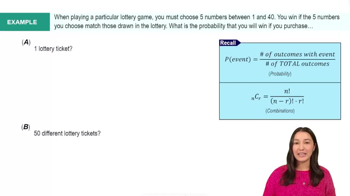Table of contents
- 0. Fundamental Concepts of Algebra3h 29m
- 1. Equations and Inequalities3h 27m
- 2. Graphs1h 43m
- 3. Functions & Graphs2h 17m
- 4. Polynomial Functions1h 54m
- 5. Rational Functions1h 23m
- 6. Exponential and Logarithmic Functions2h 28m
- 7. Measuring Angles39m
- 8. Trigonometric Functions on Right Triangles2h 5m
- 9. Unit Circle1h 19m
- 10. Graphing Trigonometric Functions1h 19m
- 11. Inverse Trigonometric Functions and Basic Trig Equations1h 41m
- 12. Trigonometric Identities 2h 34m
- 13. Non-Right Triangles1h 38m
- 14. Vectors2h 25m
- 15. Polar Equations2h 5m
- 16. Parametric Equations1h 6m
- 17. Graphing Complex Numbers1h 7m
- 18. Systems of Equations and Matrices1h 6m
- 19. Conic Sections2h 36m
- 20. Sequences, Series & Induction1h 15m
- 21. Combinatorics and Probability1h 45m
- 22. Limits & Continuity1h 49m
- 23. Intro to Derivatives & Area Under the Curve2h 9m
21. Combinatorics and Probability
Probability
Struggling with Precalculus?
Join thousands of students who trust us to help them ace their exams!Watch the first videoMultiple Choice
When drawing a marble out of a bag of red, green, and yellow marbles 8 times, a red or yellow marble is drawn 6 times. What is the probability of drawing a green marble?
A
0.025
B
0.125
C
0.25
D
0.75
 Verified step by step guidance
Verified step by step guidance1
First, understand that the probability of an event is calculated as the number of successful outcomes divided by the total number of possible outcomes.
In this problem, the total number of draws is 8, and a red or yellow marble is drawn 6 times. Therefore, the number of times a green marble is drawn is 8 - 6 = 2.
The probability of drawing a green marble is the number of times a green marble is drawn divided by the total number of draws.
Set up the probability expression: \( P(\text{green}) = \frac{\text{Number of green marbles drawn}}{\text{Total number of draws}} \).
Substitute the known values into the expression: \( P(\text{green}) = \frac{2}{8} \). Simplify this fraction to find the probability of drawing a green marble.

 5:37m
5:37mWatch next
Master Introduction to Probability with a bite sized video explanation from Patrick
Start learningRelated Videos
Related Practice








